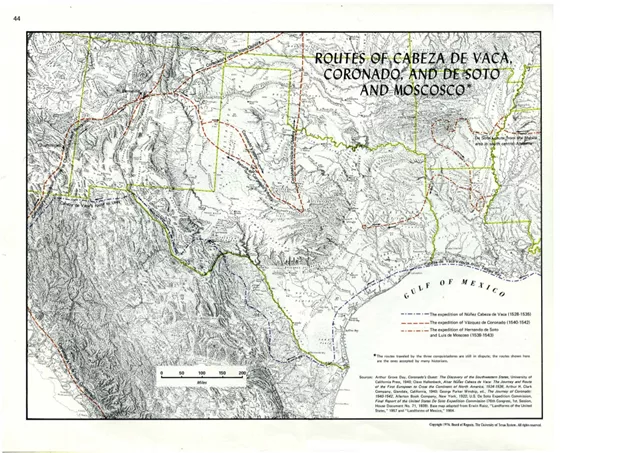
“To seek El Dorado, the conquistadors for a hundred years and more marched and countermarched from one extremity of half of the western hemisphere to the other, spending the lives of tens of thousands of men and the wealth of prodigal treasuries, enduring starvation, fever, cold, thirst, the pests of swamps and the pitilessness of deserts—all with an intrepidity that comes now in our tame “Safety First” age like a stirring cup brewed by the giants”, wrote legendary Texas folklorist J. Frank Dobie in an article entitled An Inquiry into the Sources of Treasure Legends of Texas. I love the tales of Spanish explorers and their influence on Texas history, and often wonder if they ever came here to Brown County, and if so, when and where?
Dobie examined the treasure seeking myths and legends that seemingly brought the early Spanish explorers into Texas, at least in part, but left it for others to document exactly where they went in the state, and which locations were occupied by Spanish troops. When it comes to documenting Spanish soldiers in our area, information is sparse. Nevertheless, there are some stories worth hearing that point to the possibility.
Area historian Jay Longley thinks there is reason to believe the Spanish had some sort of outpost or fort in or near Brownwood. He wrote, “Only a few years ago, a high school classmate and former Brown County Judge contacted me and told me of an experience he had when he was a kid. His dad was building a fence for a man, only a short distance from my home in Brownwood. While his father was working on the fence, the boy was using his detector in the man’s backyard when he got a signal, dug down, and recovered a small Spanish cannonball! Some years later, he had it assayed, and it was pure silver!”
“When I was young,” Longley continued, “my Dad told me that when he was a kid (probably in the 1930s) living in Brownwood, someone found some old Spanish armor in a cave on Round Mountain in the city limits of Brownwood. I’ve tried to find out more in the years since but have had no luck tracking down the story or the armor. I have learned that the Spanish were in what is now Brown County on a few occasions in the 1700s and possibly even as early as the 1500s.” .
If you think about it, the Spanish fort at the San Saba Mission was only a day or so ride from Brown County. We do know of at least one incident where Spanish soldiers entered what was likely Brown County, recounted here from the book,The Lipan Apaches :people of wind and lightning by Thomas Britten: “On a dark, stormy night in August 1723, an Apache raiding party made a daring foray on the Béxar horse herd. Despite the fact that the horses were under a ten-man guard and enclosed in a locked corral, the Apaches managed to break in and run off eighty animals. Captain Nicolas Flores y Valdéz, a career soldier who had risen through the ranks due to his bravery and ability, gave immediate pursuit, but returned empty-handed the next day. After regrouping, Flores led a force of thirty soldiers and an equal number of mission Indians to follow the Apaches’ trail. Flores pressed his men hard, stopping only briefly to decide which of five trails to follow after the Apaches split up to confuse their pursuers. On September 24, more than a month after leaving their presidio, they discovered an Apache rancheria of two hundred people near present-day Brownwood, Texas. According to Spanish reports, a six-hour battle ensued in which thirty-four Indians were killed and twenty women and children taken captive. Flores’s forces apparently routed the Indians, who fled with their families down a ravine and across a river (Pecan Bayou?) to escape.”
According to the map above that traces several Spanish adventurer’s treks through Texas, the soldiers passed very close to our area indeed. Maybe they noted the Pecan Valley as a good place to obtain a winter’s supply of pecans, a documented activity among the Spanish explorers. The only way to find out for sure is for someone to discover a cache of Spanish treasure, the lost armor, or other evidence to show there was indeed some sort of outpost here. Who knows, maybe someday that will happen!
